As both amateur and serious athletes become more in tune with their bodies, a new trend has emerged: zero-drop running. Related to the sub-disciplines of barefoot and natural running, zero-drop runners take an approach that allows feet to do what they do best: run. Zero-drop shoes are designed to give the foot protection without interfering with the natural way that a foot works.
Contents
- Factors to Consider in a Zero-Drop Running Shoe
- Top 10 Best Zero-Drop Running Shoes 2024
- 1. Best Overall Zero-Drop Running Shoe: Altra Escalante 2
- 2. Best Zero-Drop Running Shoe for Women: Merrell Women’s Vapor Glove 4 Sneaker
- 3. Best Premium Zero-Drop Running Shoe: Vibram V-Men’s Running Shoe
- 4. Oranginer Men’s Barefoot Shoes
- 5. Best Budget Zero-Drop Running Shoe: WHITIN Men’s Cross Trainer
- 6. Altra Women’s Solstice Sneaker
- 7. Merrell Men’s Vapor Glove 4 Sneaker
- 8. Best Zero-Drop Shoe for Trail Running: New Balance Men’s Minimus 10 V1 Trail Running Shoe
- 9. TSLA Men’s Trail Running Minimalist Barefoot Shoe
- 10. Brooks Men’s PureFlow 7
- Guide to Buying the Best Zero-Drop Running Shoes for 2024
- Frequently Asked Questions
- Wrapping Up
What Exactly Is a Zero-Drop Running Shoe?
While different manufacturers classify zero-drop running shoes in slightly different ways, we’ll use the following definition to define the category: a zero-drop running shoe is a shoe that keeps the ball of the foot and the heel of the foot at the same level.
While conventional running shoes with arch and heel support traditionally keep the foot’s ball and heel at different levels, a zero-drop running shoe tries to emulate the natural posture of a barefoot – which has the heel, arch, and ball of the foot all at the same height. All shoes on this list, although they accomplish the task in different ways, keep the foot in this barefoot-emulating neutral posture.
Factors to Consider in a Zero-Drop Running Shoe
Zero-drop shoes all look to maintain the foot with a neutral, natural posture, but they approach the task with different materials, designs, and constructions. If you know what you’re looking for, you can skip straight to the products, otherwise, our short guide will key you in on the basics to consider when choosing a shoe.
Type of Zero-Drop Shoe
Zero-drop shoes all have the same general principles, but different shoes emphasize different elements of zero-drop and barefoot-running philosophy.
Barefoot Running Shoe
A barefoot running shoe is a blanket term for any shoe that adheres to the principles of zero-drop, natural, and barefoot running. Many designs of shoes fit this category, but it’s more of a marketing term than a technical one.
Zero-Drop Running Shoe
A zero-drop running shoe is a technical term that describes a shoe where the ball of the foot and the heel are at the same height. Some manufacturers might not use this exact term in favor of ‘barefoot running shoe’ or ‘minimalist running shoe,’ but this the most important principle of a barefoot running shoe.
Zero-Cushion Running Shoe
Technically, a zero-drop running shoe can be cushioned as long as the shoe keeps the ball of the foot and heel at the same height. Zero-cushion running shoes contain no padding, foam, or cushioning, making them lightweight and helping the body find its natural stride.
Minimalist Running Shoe
A minimalist running shoe uses a minimal amount of material to create a running shoe, typically using simple aesthetics. While most zero-drop shoes can be considered minimalist running shoes, plenty of non-zero-drop shoes are minimalist as well.
Toe Shoes
One of the first styles to bring zero-drop shoes to the mainstream, toe shoes have an individual cutout for each toe to better emulate a barefoot. While recent scientific research says that other types of zero-drop shoes are just as effective, toe shoes continue to be popular and symbolic of the barefoot running movement.
Materials
Shoes have two main parts, an upper and a sole. Uppers are the fabric top part of a shoe, the sole is the bottom, more durable part of the shoe that comes in contact with the running surface. Since they perform different jobs, they’re made of very different materials
Sole Materials
Rubber
Most typically zero-drop shoe soles are made of synthetic rubber. Rubber is comfortable and flexible enough to not interfere with the running stride, but durable enough to protect the foot from debris.
Foam
Foam is sometimes used in zero-drop shoes used to cushion or elevate the foot. It’s more commonly seen in standard running shoes.
EVA
Standing for Ethylene-Vinyl Acetate, EVA is becoming gradually more popular due to its rubber-like softness and flexibility. It’s great for zero-drop shoes due to its light weight and damping qualities.
Upper Materials
Nylon
Nylon is a waterproof synthetic material that’s used to improve the waterproofing and durability of a specific part of a shoe. Since it’s not very breathable, it usually just makes up a small part of the construction of a shoe.
Polyester
Polyester is a synthetic material that can be manufactured to take many forms, from soft synthetic fleece linings to durable impermeable waterproof membranes. It’s one of the most widely used running shoe materials.
Synthetic Leathers
While conventional leathers aren’t used much in running shoes, synthetic leathers have taken their place as a lightweight, durable material that can contour to each wearer’s foot over time.
Width
While shoe size (Typically 1 through 15) tells us the length of the shoe, a foot exists in three dimensions. Due to the stretchy properties of a shoes ‘upper,’ the least adaptable part of a shoe is the width, and it can dramatically affect the fit and comfort of your runner. We’ve categorized the runners on our list in three categories:
- Narrow: Shoes designated on our list as narrow have small, tight toe boxes that work best with runners who have slender feet. They’re not as common as models with wide toe boxes, but they’re comfortable for those with narrow feet.
- Standard: Standard width shoes are sized according to typical manufacturer standards. Walk into a shoe store, pick an off-the-shelf model, and that shoe will probably have a relatively standard width.
- Wide: Wide shoes are designed specifically with wide and flat feet in mind. While wide-footed runners will be uncomfortable in average and narrow shoes, those with average-width feet can typically be comfortable in a wider-than-normal shoe.
Size Availability
When shopping for a zero-drop shoe, it’s important to find something that fits. Know your size before purchasing and make sure that your shoe size matches your foot as close as possible: keep in mind that shoes sold in half size increments are better than shoes that only come in full sizes, as they offer a more customized fit.
Now you know what look for, let’s check out some awesome running shoes that will serve you will as you pound the pavement. We have a more in-depth guide after our list. On your marks, get set, go!
Top 10 Best Zero-Drop Running Shoes 2024
1. Best Overall Zero-Drop Running Shoe: Altra Escalante 2
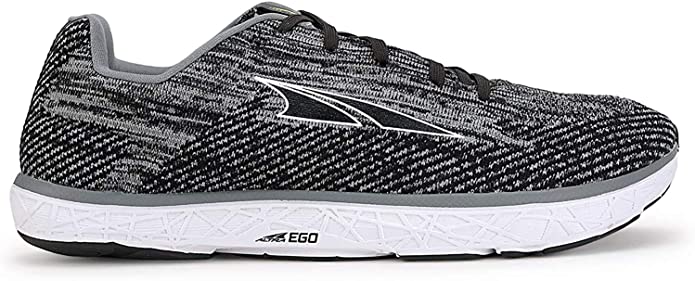
Editor’s Rating:
At a Glance:
- Type of Zero-Drop Shoe: Zero-Drop Running Shoe
- Upper Material: Engineered Knit
- Sole Material: Synthetic Upper
- Width: Standard (wide toe box)
- Size Availability: 7 to 15 in half-sizes
Altra was one of the first players to enter the zero-drop footwear market, recognizing before other major manufacturers that runners needed something promoting a more natural stride. While shoemakers like Brooks now make phenomenal zero-drop runners, Altra has been updating and improving models like the Escalante 2 for over ten years.
So what do years of innovation get you? First of all, fit: a specially engineered minimal mesh knit clings to the foot like a sock, leaving no hotspots, friction, or pinch points. A grid of articulated grooves on the sole permits the foot to flex without any restriction of movement, giving this shoe a truly barefoot feel. While the shoe has a zero-drop design, there’s still some cushioning on the bottom, making footfalls a bit less harsh on hard road surfaces, although some more experienced zero-drop runners prefer less padding.
The innovative manufacturer also makes one of our favorite women’s running shoes, the Altra Women’s Solstice Sneaker. At the end of the day, Altra proves that experience is key to making an effective zero-drop shoe, and they knocked it out of the park on this road-running barefoot-style running shoe.
- Legacy shoe manufacturer continues to upgrade zero-drop shoes
- Articulated sole grooves allow the shoe to conform to the foot
- Slightly cushioned soul helps make footfalls less harsh
- Sock-like upper means a comfortable fit
- Promotes natural stride
- Some zero-drop runners don’t like cushioning in the sole
2. Best Zero-Drop Running Shoe for Women: Merrell Women’s Vapor Glove 4 Sneaker
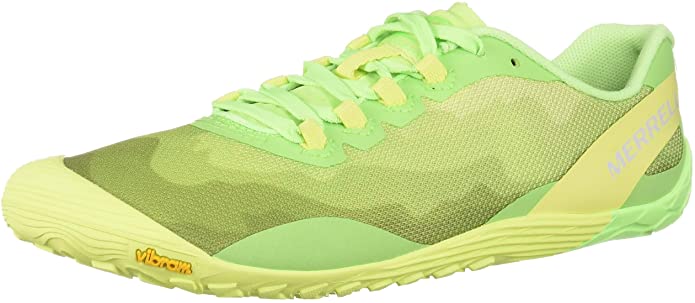
Editor’s Rating:
At a Glance:
- Type of Zero-Drop Shoe: Zero-Drop Shoe
- Upper Material: Breathable Mesh Lining
- Sole Material: Vibram Synthetic Rubber
- Width: Standard
- Size Availability: 5 to 12 in half-sizes
A minimalist zero-drop running shoe that’s at home on the trail and the road, the Vapor Glove 4 is an ultralight yet durable women’s shoe that provides just a touch of cushioning, making zero-drop running a bit more comfortable.
An integrated insole is directly attached to the rest of the shoe, which makes sockless running much more comfortable. This also has the side benefit that the shoes can be rinsed down to clean up after a dirty or muddy run. Cordura mesh, the same material used on motorcycle jackets, is not only incredibly abrasion-resistant, but it’s also particularly breathable. The fabric of the upper also incorporates a proprietary antimicrobial material that can help reduce odors.
While many other trail-style shoes opt for quick-release style laces, this model uses traditional laces, which makes adjusting tension easier. With a weight of just six ounces per shoe, these runners are remarkably lightweight and come in a wide variety of colorways from neutral tones to fun, bright fluorescent and neon colors. Our only issue is the design on the side, as the fade pattern can make it look like the shoe is dirty when it’s actually clean.
- Minimalist zero-drop shoe is great for the trail and the road
- Ultralight option for female runners
- Easy to rinse down due to an integrated insole
- Fabric uses proprietary antimicrobial material
- We’re not fans of the pattern design on the shoe’s upper
- No quick-release style laces
3. Best Premium Zero-Drop Running Shoe: Vibram V-Men’s Running Shoe
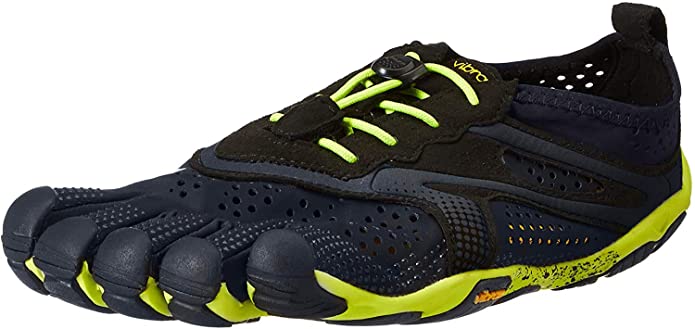
Editor’s Rating:
At a Glance:
- Type of Zero-Drop Shoe: Toe Shoe
- Upper Material: Polyester Lycra Stretch Mesh and Polyester Microfiber
- Sole Material: Synthetic Rubber
- Width: Narrow to Standard
- Size Availability: Men’s 6.5 to 15 (no half-sizes)
Vibram toe shoes are instantly recognizable: with an individual cutout for each toe, this shoe is basically a shell around the bare foot, perfectly matching each contour of the sole. According to Vibram, this presents various advantages: our feet have five individual toes for a reason, and this shoe lets each toe perform its unique job, helping with creating a more natural and comfortable stride.
While this shoe’s key innovation is its design with individually articulated toes, it still adheres to the other principles of a zero-drop shoe: a light weight (less than five ounces), a minimal design, and a flat bottom that holds the heel and arch at the same level. And it does the job well, with a soft polyester upper and a form-fitting bottom keeping the foot cool and comfortable.
For a comfortable, unique, and glove-like shoe, we only have two small issues: sizing and scientific validity. Due to the format of the shoe with cutouts for each toe, Vibram had to make some assumptions about the standard dimensions of an average foot. This makes it difficult for both wide and narrow feet alike to fit properly.
Recent studies also say that the articulated toes might not make a difference compared to other zero-drop shoes. While science says there might not be any benefit to the Vibram’s design, there aren’t any detriments to using Vibram toe shoes either—the individual toe cutouts won’t negatively affect you in any way. Our recommendation: be aware that just because a shoe says ‘Vibram’ doesn’t mean that it’s necessarily any better or worse than any other zero-drop shoe.
- Glove-like fit with individually articulated toes is as close to barefoot running as you can get
- Ultra-lightweight five-ounce construction
- Soft polyester upper keeps feet comfortable and cool
- Minimal design contains nothing superfluous
- Toe cut-outs might not make a difference compared to other zero-drop shoes
- Not great for those with wide or narrow feet
4. Oranginer Men’s Barefoot Shoes
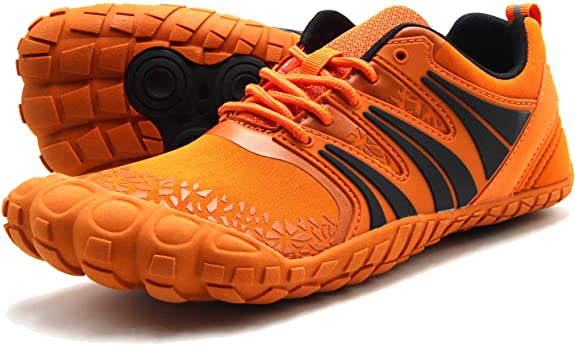
Editor’s Rating:
At a Glance:
- Type of Zero-Drop Shoe: Zero-Drop/ Barefoot Running Shoe
- Upper Material: Synthetic Polyester Mesh
- Sole Material: Memory Foam / Rubber
- Width: Standard, wide toe box
- Size Availability: 7 to 13 in full sizes
The Oranginer Men’s Barefoot Shoe evades categorization: deriving toe-shoe elements from models like the Vibram V Men’s Running Shoe and taking design cues from trail running shoes, the Oranginer is a zero-drop shoe that can be thought of in multiple ways.
While this shoe uses a zero-drop, barefoot-style construction, it isn’t a zero-cushion shoe—it utilizes an internal memory foam insole that helps many runners with some of the problems that traditionally plague zero-drop runners: notably sore feet, sore heels, and shin splints.
This shoe is relatively unique for the category: it treads the line between trail running shoe, zero-drop running shoe, and – with its cushioned sole – a traditional running shoe. At a price well below $50, it also suitable for the budget-sensitive. While versatile, though, it doesn’t notably stand out in one specific category as truly great.
No-tie laces make slipping the shoe on and off easily, and a comfortable inner fabric layer means the design can be used with or without socks. With a thicker-than-average rubber sole and a quick dry polyester mesh, it’s got some properties of a trail shoe as well.
Oranginer offers better customer support than even major running shoe manufacturers in the form of a 12-month comprehensive warranty. Since most hobby runners will run well over 500 miles per year, which is the recommended replacement interval for a zero-drop shoe, Oranginer has remarkable confidence in its products.
- Versatile design sits between trail running, zero-drop, and traditional running shoe
- Shoe has some cushioning to help prevent traditional zero-drop shoes
- 12-month comprehensive warranty
- Comfortable inner fabric liner means the shoe can be used with or without socks
- Versatility means it doesn’t stand out in any specific category as being great
5. Best Budget Zero-Drop Running Shoe: WHITIN Men’s Cross Trainer
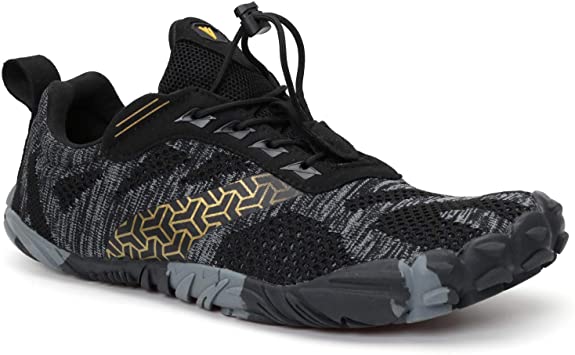
Editor’s Rating:
At a Glance:
- Type of Zero-Drop Shoe: Zero-Drop/Minimalist Running Shoe
- Upper Material: Polyester Mesh
- Sole Material: Synthetic Rubber
- Width: Standard
- Size Availability: Men’s 7-15 in full-size increments (size down)
Direct-to-consumer brand WHITIN is able to offer incredibly inexpensive shoes due to their streamlined supply chain, simple construction, and online sales model. While WHITIN isn’t a shoe manufacturer as well-known as companies like New Balance and Brooks, its newcomer status is clearly not a disadvantage for the up-and-coming company, proved by their release of this excellent budget-priced zero-drop shoe.
A minimalist shoe with some off-road characteristics, the WHITIN Cross Trainer is great for everything from weight lifting to running, hiking, and ultra-endurance trail races. A multipurpose construction utilizes a slightly thicker-than-average sole which protects the foot during intense athletic activities, although it deadens road feel, making the shoe feel a bit more like a conventional runner.
Sizing is about average, and the width of the toe box, although comfortable, doesn’t accommodate those with wide feet particularly well. We like their use of non-tie laces that makes slipping these shoes on quick and easy; we also appreciate the comfortable edge-less design of the inside of the shoe which makes it possible (even preferable) to run in these shoes without socks.
- Off-road shoe also works for road runners and non-running athletes
- Budget price provides excellent value for zero-drop runners
- Edgeless design is great for sockless athletes
- Multipurpose construction helps protect the sole of the foot
- Thicker sole makes the shoe feel a bit more like a traditional running shoe
6. Altra Women’s Solstice Sneaker
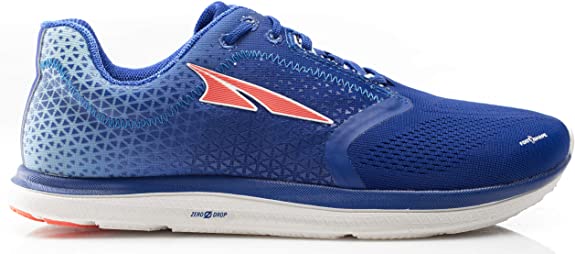
Editor’s Rating:
At a Glance:
- Type of Zero-Drop Shoe: Zero-Drop Running Shoe
- Upper Material: Polyester Mesh
- Sole Material: Exposed EVA
- Width: Standard
- Size Availability: Women’s 6 to 11 in half sizes
With a light cushion and a slightly heavier weight of six ounces per shoe, these Altra Women’s Solstice Sneakers are a slightly more substantial zero-drop running shoe. They use EVA foam in the sole, a slightly more cushioned option than more common sole materials. For this reason, these shoes are perfect for runners who find that standard rubber soles in zero-drop running shoes can be a bit harsh on the feet.
Although there is some cushioning, these shoes don’t betray their zero-drop roots—the shoe is basically a barefoot shoe on a platform of EVA foam. A raised footbed with 23mm of elevation protects the foot from smacking harshly on hard road surfaces, but the footbed itself is designed to mimic how a barefoot naturally rests on the ground.
While the light cushioning on this shoe makes it a good starter option for those just getting into zero-drop and barefoot running, the upper can be constricting on the foot. It has a standard size construction paired with a slightly wide toe box, which works well for those with average and narrow feet but still won’t accommodate most wide feet. We’d recommend sizing up a half size if you have broad or flat feet.
- EVA foam helps cushion the foot from hard running surfaces
- Great starter option for runners new to zero-drop shoes
- Footbed mimics how the bare foot naturally rests on the ground
- Works well for those with average feet
- Not ideal for runners with wide feet
- Upper can be slightly restrictive on the foot
7. Merrell Men’s Vapor Glove 4 Sneaker

Editor’s Rating:
At a Glance:
- Type of Zero-Drop Shoe: Zero-Drop Running Shoe/Barefoot Running Shoe
- Upper Material: Ultra-Lightweight Mesh
- Sole Material: Synthetic (made by Vibram)
- Width: Narrow
- Size Availability: 7 to 15 in half sizes
Merrell is a legendary shoe manufacturer in the zero-drop shoe space, designing and producing high-quality, minimalist shoes back to 1981. The manufacturer continues to be at the cutting edge of the space, incredibly popular for runners that have been longtime advocates of barefoot running.
Merrell continues to impress with one of their lightest and most minimal shoes yet, creating a shoe that protects the foot while being almost completely unnoticeable when running. Helping accomplish the feat is Vibram’s proprietary sole, which Merrell incorporates into their shoe design and construction. Some runners, especially beginners, say that the road-feel with this sole can be a bit hard on the foot.
The company also incorporates reused materials in the construction of the shoe, which reduces the environmental impact of the shoe. Always thoughtful with their manufacturing and design, the Merrell Vapor Glove 4 is a shoe that’s perfect for those who completely embrace a zero-drop shoe that’s as close to the bare foot as possible.
- Lightweight feel and perfect fit feels like running barefoot
- Incorporates a Vibram sole into construction
- Reused materials reduce environmental impact
- High-quality, minimalist manufacturing
- Runners new to barefoot running don’t like the road feel
- Sole can be harsh on the foot
8. Best Zero-Drop Shoe for Trail Running: New Balance Men’s Minimus 10 V1 Trail Running Shoe
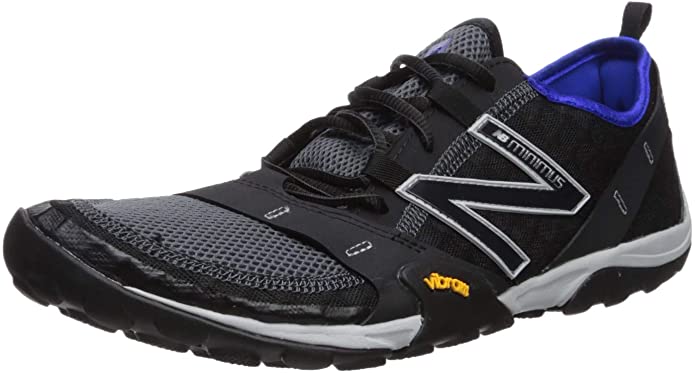
Editor’s Rating:
At a Glance:
- Type of Zero-Drop Shoe: Minimalist Running Shoe
- Upper Material: 50% synthetic / 50% mesh
- Sole Material: Synthetic Rubber
- Width: Standard, 7 to 14 available in wide
- Size Availability: Men’s 5 to 14 in half sizes
A trail running shoe coming with an attractive design and a minimalist construction, the Minimus Trail 10v1 is a zero-drop shoe with a more heavy-duty approach to barefoot running. An upgraded upper material helps the shoe comfortably wrap around the top of the foot and a sticky-patterned rubber provides grip on rock, dirt, and other slippery trail surfaces. Along with having a zero-drop sole, the footbed is articulated which helps the shoe move with the foot.
Available in a wide variety of color variations, the shoe also counts on a full spectrum of sizes available, down to the half size. Sizes seven and up come in a ‘W’ option that accommodates those with broader feet, leaving this shoe with over 30 sizing combinations—so you’re sure to find something that fits. Those with narrow feet or those seeking a tight upper should look elsewhere.
- Heavy-duty approach to barefoot running is great for trail running
- Articulated footbed helps the shoe move with the foot
- Sticky rubber grips rock, dirt, and slippery trails
- Wide option accommodates broad feet
- Loose upper doesn’t work for those looking for a tight fit
- Not for runners with narrow feet
9. TSLA Men’s Trail Running Minimalist Barefoot Shoe
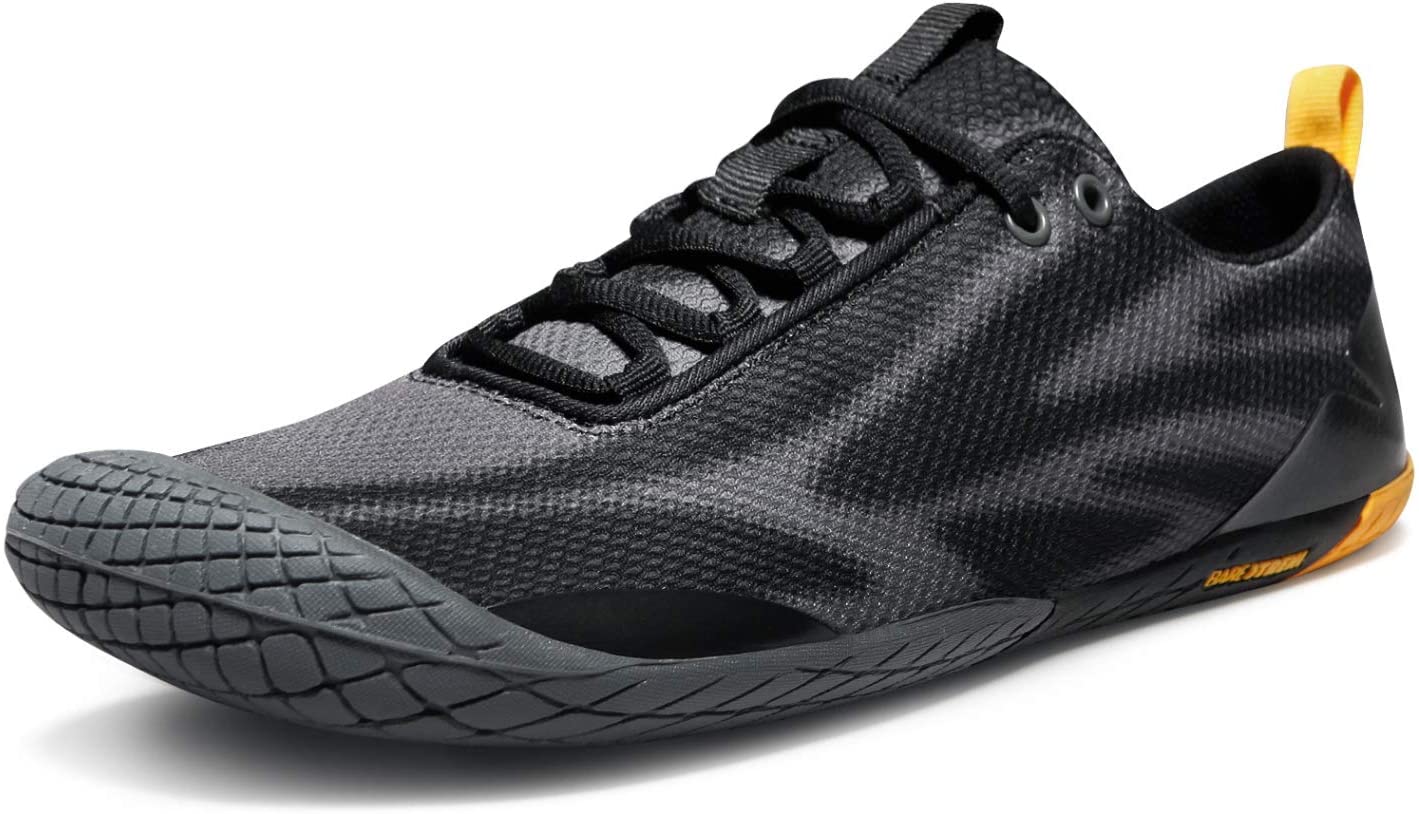
Editor’s Rating:
At a Glance:
- Type of Zero-Drop Shoe: Minimalist Shoe, Zero-Drop Shoe
- Upper Material: Dirtproof Waxed Upper with Nylon Support Band
- Sole Material: Cushioned Synthetic Rubber
- Width: Standard (size down)
- Size Availability: 6.5 to 13 in half-sizes
With an ultra-minimalist form factor similar to the Merrell Vapor Glove 4, small shoe manufacturer TSLA creates a simple and comfortable zero-drop shoe that’s sturdy enough for the trails. While the shoe is zero-drop, it maintains a slight amount of cushioning, helping to insulate the foot and heel from heavy footfalls.
Weighing in at a mere 3.2 ounces per shoe, these lightweight runners are about as heavy as a deck of cards—running will never feel so airy. The synthetic rubber outsole provides grip on all surfaces from roads to rocky trails, giving runners confidence to speed through technical trail sections. The center of the shoe is supported by a nylon band, helping anchor the foot to the sole. A dirtproof upper is also great for the trails, meaning you won’t end up with a dusty pair every time you come back from your run.
Some runners prefer traditional laces to the speed-style laces included on this shoe. We’re mostly impressed by the fact that TSLA can produce a shoe that rivals Merrell for about a third of the price. A quick note—we’d strongly recommend going a half-size down with these shoes to get a glove-like fit.
- Rivals more expensive shoes at a lower price
- Synthetic rubber gives grip on all surfaces
- Maintains a slight amount of cushioning
- The grip is good for technical sections
- Some runners prefer traditional laces to speed-style laces
- Size a half-size down
10. Brooks Men’s PureFlow 7
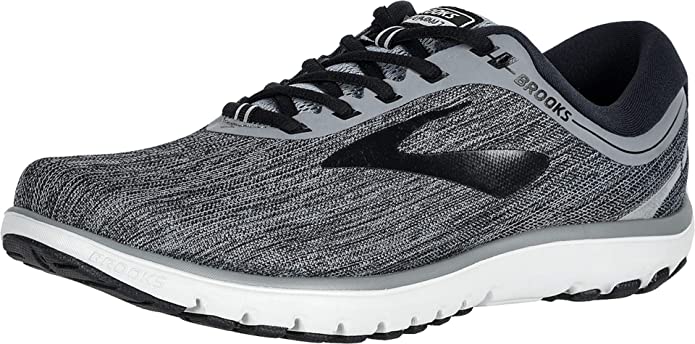
Editor’s Rating:
At a Glance:
- Type of Zero-Drop Shoe: Minimalist Running Shoe
- Upper Material: Stretch-Weave Mesh
- Sole Material: Gum Rubber
- Width: Standard/Narrow
- Size Availability: 5 to 14 in half sizes
With the PureFlow 7, Brooks has created a barefoot-style shoe that works for runners who need slightly more support. Looking more like a traditional running shoe, the minimalist runner comes primarily in neutral, unobtrusive color palettes. A gum rubber sole is soft and forgiving enough for hard road and track surfaces, a stretch-weave mesh upper hugs the foot to help the shoe feel as unobtrusive as possible.
An important note: the Brooks Men’s PureFlow 7 has some slight midsole support which means it isn’t technically a zero-drop shoe. For those interested in barefoot or zero-drop running, it’s still worth a look, especially if you’re having trouble transitioning to a full blown zero-drop shoe.
There are many runners that have run on conventional shoes for years and years. For these runners, an abrupt transition to a zero-drop shoe can be uncomfortable. The Brooks PureFlow 7 is still a minimalist, barefoot-style shoe, but slight arch support helps aid the transition. Many runners will use these as an intermediary step to running with a complete zero-drop shoe. For others that need some degree of arch support, this is as close to barefoot running as possible.
- Great shoe for zero-drop-curious runners who need some arch support
- Neutral, unobtrusive color palettes
- Soft gum rubber sole good for road running
- Stretch-weave mesh upper hugs the foot
- Not technically a zero-drop shoe
Guide to Buying the Best Zero-Drop Running Shoes for 2024
The young category of zero-drop running shoes grows more and more diverse every month in terms of price, design, and materials. Manufacturers are still trying to figure out exactly what works best in minimalist-style shoes.
A History of Barefoot Running
Humans are expert runners by nature—tens of thousands of years ago, our ancestors would find food by chasing it down, and they were able to accomplish this incredible feat simply due to their natural running ability.
Conventional Running Shoes
Humans haven’t changed much since then, but running shoe technology has. Starting with leather boots, then transitioning rubber-soled Chuck Taylors, and later to the ultra-supportive and ergonomic running shoes popularized by manufacturers like Nike and Brooks, modern running shoes dramatically change the anatomy of how we run.
For a long time, these technological advancements in running shoes were considered cutting edge, thought to increase running speed and efficiency. But what if modern shoes were counterproductive? What if our feet are naturally good at running and don’t need layers of plastic and rubber support to help them do their job? What if all we needed was a small protective layer to protect the delicate soles of our feet from debris like rocks and glass?
Zero-Drop Running Shoes
This is where zero-drop running shoes come in. With the philosophy that the best thing we can do for our feet is to leave them alone, zero-drop running shoes are made of a single layer of rubber that allows our feet to interface with the road surface without interference.
Advocates of these shoes say that they can improve running comfort, reduce running-related injuries, or even increase running speed. Although the benefits of barefoot running and zero-drop running shoes are still being discovered, one thing is for sure: those who start using zero-drop running shoes hardly ever go back.
Zero-Drop, Zero-Cushioning, or Minimalist: Which Is Right for Me?
The answer to this question is complicated: due to the young age of the barefoot/zero-drop community, categories are still being defined, and each type of shoe can overlap with other categories of shoes.
The best way to know what’s right for you is to try a shoe out. If you’re already an experienced runner, you’ll probably have some idea of how you run and what you like in a shoe. If you’re just starting out, pick a properly-fitting zero-drop or minimalist shoe and go from there.
One thing great about running shoes is their inexpensive price compared to other sporting equipment, meaning you can buy and experiment with shoes as you develop as a runner. Don’t be afraid, make a decision, and reevaluate in a couple of hundred miles.
Barefoot Running and Zero-Drop Shoes
While the zero-drop running shoe movement was originally started by runners who advocated for true barefoot running, without any shoe at all, most of today’s enthusiasts understand that running with a completely exposed fit is not practical for most hobbyists. Anatomically, using a zero-drop shoe is almost identical to running completely barefoot.
Protection and Durability
Just because a shoe is a barefoot-style zero-drop model doesn’t mean it is fragile or even lightweight. Zero-drop shoes oriented towards trail runners are created with intense performance demands in mind, and manufacturers understand that trail runners require a durable shoe that protects fragile feet from injury.
Other ultra-minimal ultra-lightweight running shoe designs are designed as minimally as possible, with only a few ounces of rubber and fabric making up the entire construction. These are typically designed to offer less protection and are sold to road or track runners.
Zero-Drop Shoes for Non-Running Workouts
While zero-drop shoes are typically most popular with barefoot runners, the style of shoe can benefit athletes in other sports: ball sport athletes, crossfitters, weightlifters, and even office workers can benefit from a zero-drop shoe.
While runners were the first advocates of zero-drop shoes and barefoot running, the same principles apply to other sports and activities. Zero-drop shoes can help reduce the frequency of injury when lifting and help with posture and comfort issues. Office workers who stand for much of their day report less leg fatigue and more energy when wearing zero-drop shoes.
Transitioning to a Zero-Drop Shoe
Due to how the human body accustoms to using a particular running shoe, switching over to a zero-drop runner is a bit more complicated than popping it on and heading out on the road. A transition to a barefoot-style running shoe is a big deal—those who have a hard time adapting report shin splints, mild discomfort, and foot pain.
The more you’ve run with traditional running shoes, the longer it will take to adapt. While zero-drop running shoes have numerous benefits, standard running shoes – fit properly – can help align the stride of runners, especially those who have an asymmetrical running gait. While zero-drop running shoes can help these people, often a conventional shoe works better.
Many runners find success transitioning to zero-drop shoes by using a conventional shoe on workout days and a zero-drop shoe on light days. Others drop their mileage after purchasing a zero-drop shoe, working their way back up to bigger mileages over time.
Zero-Drop Running Resources
Born to Run
A documentary that brought barefoot running to the mainstream, Born to Run is a critically-acclaimed piece that has revolutionized how runners think about footwear. It’s a great primer on exactly why and how barefoot and zero-drop running works.
Rich Roll
Famous ultra-endurance athlete Rich Roll is a huge advocate of zero-drop running, using barefoot running philosophies and strategies to push the boundaries of human performance. He has a podcast and a blog, both of which contain a wealth of information for everyone from zero-drop running beginners to barefoot-running experts.
Runner’s World
Running publication Runner’s World has a dedicated section on running barefoot for zero-drop enthusiasts. Coming from a conventional running perspective, the magazine/website is great at providing a balanced perspective on zero-drop running.
Frequently Asked Questions
Zero-drop running comes with a whole new style and approach that can be difficult to figure out on your own. Many runners have questions when making the transition.
Do Zero-Drop Running Shoes Reduce Injury?
There is both anecdotal and clinical evidence that indicates zero-drop shoes, along with many other benefits, can lower the incidence of the repeated-use injuries commonly seen in runners.
A zero-drop shoe adheres to the same principles of barefoot running while protecting the fragile sole of the foot, important to lessen the risk of cuts from road debris. By providing a solid surface to protect the sole of the foot, but not using padding to affect the stride, the foot can be both protected while still maintaining its natural gait.
How Do I Get Into Barefoot or Zero-Drop Running?
Barefoot running is one of the most accessible sports in the world. For under $50, you can buy all the equipment necessary to walk out your door and enjoy the world from a new perspective, improving your physical health, mental health, and enjoying a new pastime.
While you can spend hundreds of dollars on fitness trackers, nutrition, multiple shoes, and indoor running equipment, the only thing you fundamentally need for barefoot or zero-drop running is a pair of shoes and some athletic clothing.
Are Zero-Drop Running Shoes Good for Running?
The truth about running shoes is that different shoes work for different types of people. There are plenty of super-experienced runners that would never touch a zero-drop shoe, and plenty of zero-drop runners that would never touch a conventional shoe. Other runners use both types of shoes.
The process of becoming a runner is ever-evolving and finding running shoes that work for you is one of the most difficult and important parts. So are zero-drop shoes good for running? Absolutely. Just keep in mind that, just like with conventional running shoes, every zero-drop shoe might not work for every person. Just like running itself, finding the right zero-drop shoe is a journey.
How Long Will Zero-Drop Shoes Last?
Zero-drop shoes typically hold up about as long as conventional shoes, if not slightly longer. Since you no longer rely on foam support or cushioning to hold up your arch or heel, the sole of the shoe will wear evenly. Expect 400 to 500 miles, but weight, running surface, and your natural running stride can all affect that number.
Can I Use Zero-Drop Running Shoes for Trail Running?
Yes! In fact, zero-drop shoes have particular advantages when used for trail running. Experienced trail runners know that one of the most important parts of off-road running is understanding the terrain, and zero-drop shoes allow you to do that on a subconscious level.
With a thin sole helping transmit the surface of the trail to the bare foot, zero-drop shoes help off-road runners with foot placement, balance, and injury prevention. Many runners also report feeling more in tune with their environment, saying that zero-drop and barefoot running help them getting ‘in a groove or ‘in the zone.’ For those who’ve been there, it’s an experience like no other.
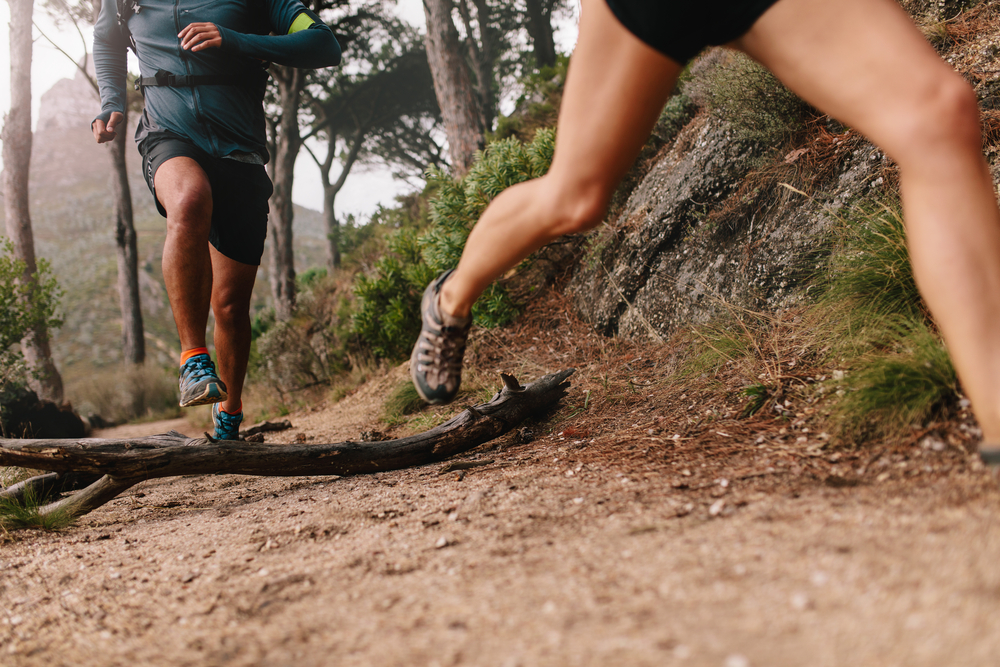
Wrapping Up
Minimalist running with zero-drop running shoes isn’t just about increasing speed, reducing injuries, or using an ultra-lightweight shoe, it’s about a whole experience of increased wellness. As the world around us becomes ever more and more complex, a simple running shoe that embraces our natural stride can teach us that simplicity might just be one of the keys that helps make our lives better. See you out there!
